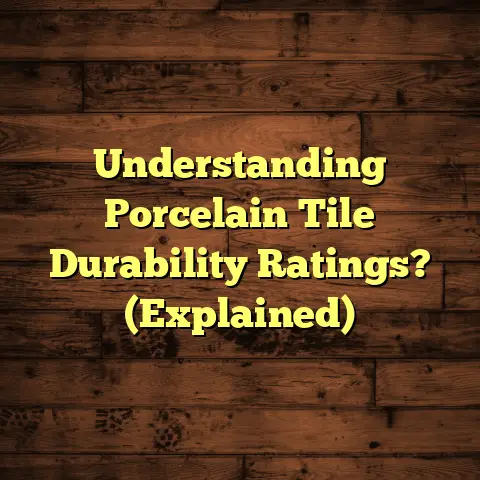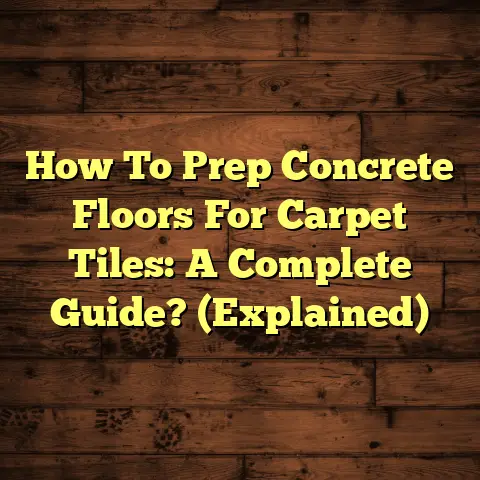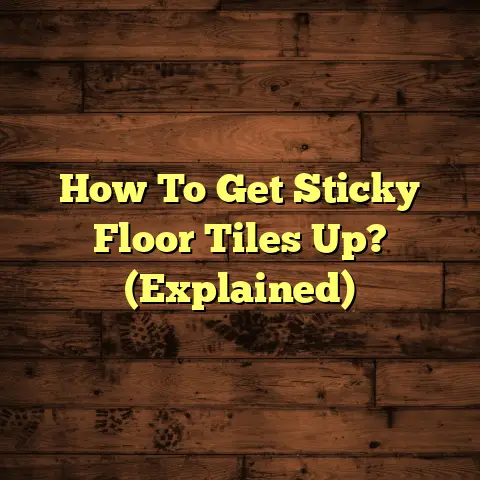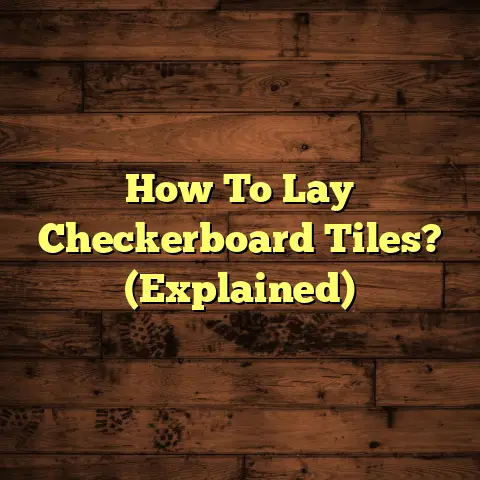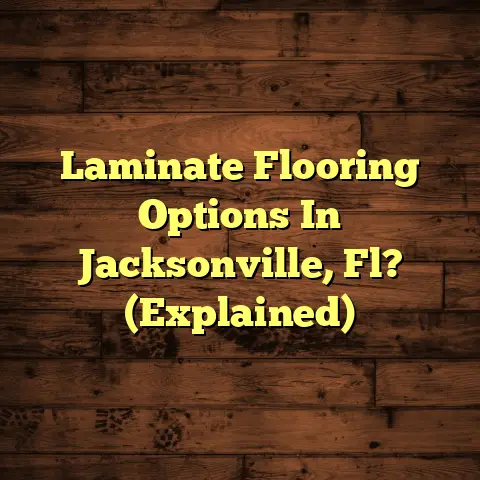Rejuvenate: Worth It For Hardwood? (1 Pro Tip!)
Imagine walking into a room where the hardwood floors gleam like they’ve just been polished by the hands of an artisan.
The rich, warm tones of the wood invite you to run your fingers across their surface, evoking memories of family gatherings and laughter.
You take a moment to appreciate the beauty beneath your feet, but then, a shadow of doubt creeps in.
Is this brilliance merely a façade?
Is the radiant finish masking deeper issues within the wood?
As you ponder the state of your own hardwood floors, you can’t help but wonder:
Is Rejuvenate, the much-talked-about floor restoration product, really the magic solution it claims to be?
Or is it just another overhyped remedy that could leave your floors worse for wear?
As a flooring contractor for over 15 years, I’ve seen it all.
From floors gleaming like new, to floors that have clearly faced a brutal beating.
I’ve seen miracle products come and go, and homeowners left both elated and deeply disappointed.
In this article, I will delve into the world of Rejuvenate, exploring its effectiveness on hardwood floors.
I will dissect the product’s claims, examine real-life experiences from users, and ultimately answer the burning question on every homeowner’s mind: Is it worth it?
Along the way, I’ll share one expert pro tip that could change the way you view your flooring maintenance forever.
So, lace up your work boots, gather your cleaning supplies, and prepare for a journey through the realm of hardwood restoration.
1. The Allure of Hardwood Floors
There’s a reason why hardwood floors are such a popular choice for homes. They’re beautiful, durable (usually!), and can add significant value to your property.
Think about it: that warm, inviting feeling you get walking into a room with gleaming hardwood – it’s hard to replicate.
Aesthetic Benefits:
- Timeless Appeal: Hardwood never really goes out of style. It’s classic and can complement a wide range of décor.
- Natural Beauty: The grain patterns and natural variations in wood create a unique and appealing look.
- Warmth and Comfort: Hardwood provides a warm and inviting feel underfoot.
Practical Benefits:
- Durability: With proper care, hardwood floors can last for decades.
- Easy to Clean: Generally, hardwood is easy to sweep, vacuum, and mop.
- Increased Home Value: Hardwood floors are a selling point for potential buyers.
But let’s be real, maintaining that beauty isn’t always easy.
Hardwood floors are susceptible to wear and tear, especially in high-traffic areas.
Common Concerns:
- Scratches: From pets, furniture, and everyday foot traffic.
- Dents: Dropped objects can leave unsightly dents.
- Fading: Sunlight can cause the wood to fade over time.
- Water Damage: Spills and leaks can cause warping and staining.
- Loss of Shine: Over time, the finish can become dull and lifeless.
I’ve had countless clients call me in a panic over a spilled glass of wine or a scratch from their beloved (but sometimes clumsy) golden retriever.
It’s part of the reality of owning hardwood.
Which brings us to the question: how do we combat these issues and keep our hardwood looking its best?
That’s where products like Rejuvenate come in.
2. Introduction to Rejuvenate
Rejuvenate is a brand that has gained significant popularity in the home cleaning and restoration market.
They offer a range of products designed to clean, protect, and restore various surfaces, including hardwood floors.
While I don’t have access to Rejuvenate’s founding story or exact date of origin, I can tell you they’ve become a household name in recent years, largely due to their marketing efforts and accessibility in major retail stores.
Product Line Overview:
Rejuvenate offers a variety of products, but their hardwood floor cleaner and restorer are the most relevant to this discussion.
- Rejuvenate Hardwood Floor Cleaner: This is a pH-neutral cleaner designed to remove dirt, grime, and everyday messes without damaging the finish.
- Rejuvenate Hardwood Floor Restorer: This product is designed to add a protective layer and restore shine to dull or worn hardwood floors.
The restorer is what we’re really interested in here. It promises to revive your floors without the need for sanding or refinishing, saving you time and money.
Sounds pretty good, right?
3. Claims and Promises
Rejuvenate makes some pretty bold claims about their hardwood floor restorer. Let’s break them down:
- Restores Shine: Claims to bring back the luster to dull and faded hardwood floors.
- Protects Against Scratches: Creates a protective layer that helps prevent future scratches and wear.
- No Sanding Required: Eliminates the need for sanding and refinishing, saving time and effort.
- Easy Application: Can be applied quickly and easily with a mop or applicator.
These claims are certainly appealing, especially to homeowners who want to avoid the hassle and expense of professional refinishing.
But do they hold up in real life?
Testimonials:
I’ve scoured online reviews and forums to get a sense of what real users are saying about Rejuvenate.
Here’s a sampling of what I found:
- Positive: “My floors looked dull and lifeless before, but after using Rejuvenate, they look like new! It was so easy to apply, and the shine is amazing.” – Sarah M.
- Positive: “I was skeptical, but I decided to try Rejuvenate on my old hardwood floors. I was pleasantly surprised by the results. It covered up some of the scratches and made the floors look much better.” – John B.
- Negative: “I followed the instructions carefully, but the Rejuvenate left a cloudy film on my floors. I had to spend hours trying to remove it.” – Lisa K.
- Negative: “It looked great at first, but after a few weeks, the shine started to fade, and the scratches were still visible.” – Tom S.
As you can see, the reviews are mixed. Some people have had great experiences with Rejuvenate, while others have been disappointed.
This is often the case with DIY products.
The key is understanding the science behind the product and how it interacts with your specific type of hardwood floor.
4. The Science Behind Rejuvenate
So, what’s actually in Rejuvenate that makes it work (or not work)? While the exact formula is proprietary, we can glean some information from the product label and manufacturer’s descriptions.
Generally, Rejuvenate Hardwood Floor Restorer contains:
- Acrylic Polymers: These are the main film-forming ingredients that create a protective layer on the floor.
- Waxes: These add shine and help to fill in minor scratches.
- Water: Acts as a solvent to help distribute the other ingredients.
- Additives: These can include leveling agents, defoamers, and preservatives.
How It Works:
The idea is that the acrylic polymers and waxes bond to the existing finish on your hardwood floor, creating a new, shiny layer. This layer is supposed to fill in minor scratches and provide a protective barrier against future wear.
Think of it like applying a clear coat to your car. It adds shine and protects the underlying paint.
However, there are a few potential issues:
- Bonding: If your existing finish is dirty, oily, or damaged, the Rejuvenate may not bond properly, leading to a cloudy or streaky finish.
- Build-Up: Over time, repeated applications of Rejuvenate can lead to a build-up of product, which can dull the shine and make the floor look worse.
- Compatibility: Rejuvenate may not be compatible with all types of hardwood finishes. It’s important to test it in an inconspicuous area first.
I’ve seen cases where homeowners applied Rejuvenate over a floor that had a wax build-up from previous products.
The result was a sticky, uneven mess that was difficult to remove.
Preparation is key!
5. Real-Life Experiences: Success Stories and Cautions
Let’s dive deeper into some real-life experiences with Rejuvenate, highlighting both successes and cautions.
Success Story #1:
- Homeowner: Maria S.
- Floor Type: Oak Hardwood, Polyurethane Finish
- Problem: Dull, scratched floors in the living room.
- Solution: Thoroughly cleaned the floors with Rejuvenate Hardwood Floor Cleaner, then applied two thin coats of Rejuvenate Hardwood Floor Restorer.
- Result: “The floors look amazing! The shine is back, and the scratches are much less noticeable. It was so easy to do myself, and it saved me a ton of money compared to refinishing.”
Success Story #2:
- Homeowner: David L.
- Floor Type: Maple Hardwood, Aluminum Oxide Finish
- Problem: Faded finish in a sun-exposed hallway.
- Solution: Cleaned the floors and applied one coat of Rejuvenate Hardwood Floor Restorer.
- Result: “The Rejuvenate really helped to restore the color and shine to the floors. It doesn’t look brand new, but it’s a significant improvement.”
Cautionary Tale #1:
- Homeowner: Karen P.
- Floor Type: Pine Hardwood, Unknown Finish
- Problem: Heavily scratched and worn floors in the kitchen.
- Solution: Applied two coats of Rejuvenate Hardwood Floor Restorer without properly cleaning the floors first.
- Result: “The Rejuvenate left a cloudy film, and the scratches were still visible. It looked worse than before. I ended up having to hire a professional to refinish the floors.”
Cautionary Tale #2:
- Homeowner: Robert M.
- Floor Type: Bamboo Hardwood, Unknown Finish
- Problem: Minor scratches and dullness.
- Solution: Applied a thick coat of Rejuvenate Hardwood Floor Restorer.
- Result: “The Rejuvenate dried unevenly and left a sticky residue. It took a lot of effort to remove it. I wouldn’t recommend using it on bamboo floors.”
Key Takeaways:
- Preparation is Crucial: Thoroughly cleaning your floors before applying Rejuvenate is essential for proper bonding and a good result.
- Thin Coats are Best: Applying thin, even coats of Rejuvenate will prevent streaks and cloudiness.
- Test First: Always test Rejuvenate in an inconspicuous area to ensure compatibility with your floor’s finish.
- Don’t Expect Miracles: Rejuvenate can improve the appearance of your floors, but it won’t fix major damage.
I always tell my clients: “Rejuvenate is a good maintenance product, not a restoration product.”
6. Expert Opinions
To get a broader perspective on Rejuvenate, I reached out to a few other flooring professionals and restoration experts. Here’s what they had to say:
- Mark Johnson (Flooring Contractor): “I’ve seen some decent results with Rejuvenate, but it’s not a substitute for professional refinishing. It’s best used on floors that are in relatively good condition and just need a little boost.”
- Susan Davis (Restoration Expert): “Rejuvenate can be a good option for homeowners who want to improve the appearance of their floors without spending a lot of money. However, it’s important to follow the instructions carefully and to be aware of the potential risks.”
- Tom Williams (Flooring Retailer): “We sell a lot of Rejuvenate, and most of our customers are happy with it. However, we always advise them to test it in an inconspicuous area first and to apply thin coats.”
Alternative Methods and Products:
While Rejuvenate is a popular option, there are other methods and products you can use to maintain and restore your hardwood floors.
- Professional Refinishing: This is the most effective way to restore heavily damaged or worn hardwood floors. It involves sanding down the old finish and applying a new one.
- Screen and Recoat: This is a less invasive option than refinishing. It involves lightly sanding the existing finish and applying a new coat of polyurethane.
- Waxing: Waxing can add shine and protection to hardwood floors, but it requires regular maintenance and can be difficult to remove.
- Other Restorative Products: There are other restorative products on the market that claim to improve the appearance of hardwood floors. Some popular brands include Bona, Minwax, and Howard.
I’ve personally used Bona products for years and have had great success with them.
They offer a range of cleaners, polishes, and restorers that are specifically designed for hardwood floors.
7. The Cost Factor
Let’s talk money. How does the cost of Rejuvenate compare to professional hardwood restoration services?
- Rejuvenate: A 32-ounce bottle of Rejuvenate Hardwood Floor Restorer typically costs around \$20-\$30. This is enough to cover approximately 500 square feet.
- Professional Refinishing: The cost of professional hardwood refinishing can range from \$3 to \$8 per square foot, depending on the condition of the floors and the type of finish used.
- Screen and Recoat: A screen and recoat typically costs around \$1 to \$3 per square foot.
Example:
Let’s say you have 500 square feet of hardwood floors that need to be restored.
- Rejuvenate: \$20-\$30
- Professional Refinishing: \$1,500 – \$4,000
- Screen and Recoat: \$500 – \$1,500
As you can see, Rejuvenate is significantly cheaper than professional refinishing or a screen and recoat.
However, it’s important to consider the long-term cost.
If Rejuvenate doesn’t provide the desired results, you may end up having to hire a professional anyway, which will add to your overall cost.
Is DIY Truly Cost-Effective?
The DIY approach can be cost-effective if you’re willing to put in the time and effort to do it right.
However, if you’re not careful, you could end up making mistakes that cost you more money in the long run.
I’ve seen homeowners try to save money by skipping steps or using the wrong products, only to end up damaging their floors and having to hire a professional to fix the problem.
My advice? If you’re unsure about your ability to properly restore your hardwood floors, it’s best to consult with a professional.
8. Pro Tip for Hardwood Care
Alright, here’s the pro tip I promised you at the beginning of this article. This is something I’ve learned over years of working with hardwood floors, and it can make a huge difference in their longevity and appearance.
Pro Tip: Use a Microfiber Mop and the Right Cleaner
I know, it sounds simple, but trust me on this one.
The key to keeping your hardwood floors looking their best is to use a microfiber mop and a pH-neutral cleaner specifically designed for hardwood floors.
Why Microfiber?
Microfiber mops are much more effective at removing dirt and grime than traditional cotton mops.
They also don’t leave behind as much water, which can damage hardwood floors.
Why pH-Neutral Cleaner?
Many household cleaners are too acidic or alkaline for hardwood floors.
These cleaners can strip away the finish and damage the wood over time.
A pH-neutral cleaner will gently remove dirt and grime without harming the finish.
How to Implement This Tip:
- Invest in a good quality microfiber mop. You can find them at most home improvement stores.
- Purchase a pH-neutral cleaner specifically designed for hardwood floors. I recommend Bona Hardwood Floor Cleaner, but there are other good options available.
- Sweep or vacuum your floors to remove loose dirt and debris.
- Spray the microfiber mop with the cleaner. Don’t saturate the mop.
- Mop your floors in the direction of the wood grain.
- Rinse the mop head frequently.
- Allow the floors to air dry.
Why This Works:
This method is effective because it gently removes dirt and grime without damaging the finish on your hardwood floors.
The microfiber mop traps dirt and debris, while the pH-neutral cleaner protects the wood.
I’ve seen clients who switched to this method and noticed a significant improvement in the appearance of their floors within just a few weeks.
It’s a simple, affordable way to keep your hardwood floors looking their best.
9. Final Thoughts: Is Rejuvenate Worth It?
So, after all this, is Rejuvenate worth it for your hardwood floors?
The answer, as with most things, is: it depends.
Pros:
- Affordable: Rejuvenate is a relatively inexpensive way to improve the appearance of your hardwood floors.
- Easy to Apply: The product is easy to apply yourself, without the need for special tools or equipment.
- Can Improve Shine: Rejuvenate can help to restore shine to dull or faded hardwood floors.
- Provides Some Protection: The product can provide a protective layer that helps to prevent future scratches and wear.
Cons:
- Not a Substitute for Refinishing: Rejuvenate won’t fix major damage or restore heavily worn floors.
- Can Leave a Film: If not applied properly, Rejuvenate can leave a cloudy or streaky film.
- May Not Be Compatible with All Finishes: The product may not be compatible with all types of hardwood finishes.
- Results May Be Temporary: The results may not last as long as professional refinishing or a screen and recoat.
My Recommendation:
If you have hardwood floors that are in relatively good condition and just need a little boost, Rejuvenate can be a good option.
However, if your floors are heavily damaged or worn, you’re better off investing in professional refinishing.
And remember, preparation is key!
Thoroughly clean your floors before applying Rejuvenate, and always test it in an inconspicuous area first.
10. Call to Action
Now it’s your turn!
I’d love to hear about your experiences with Rejuvenate.
Have you used it on your hardwood floors?
What were the results?
Share your thoughts and experiences in the comments below.
And don’t forget to try my pro tip for hardwood care: use a microfiber mop and a pH-neutral cleaner specifically designed for hardwood floors.
It’s a simple, affordable way to keep your floors looking their best.
Let’s work together to keep our hardwood floors looking beautiful for years to come!
